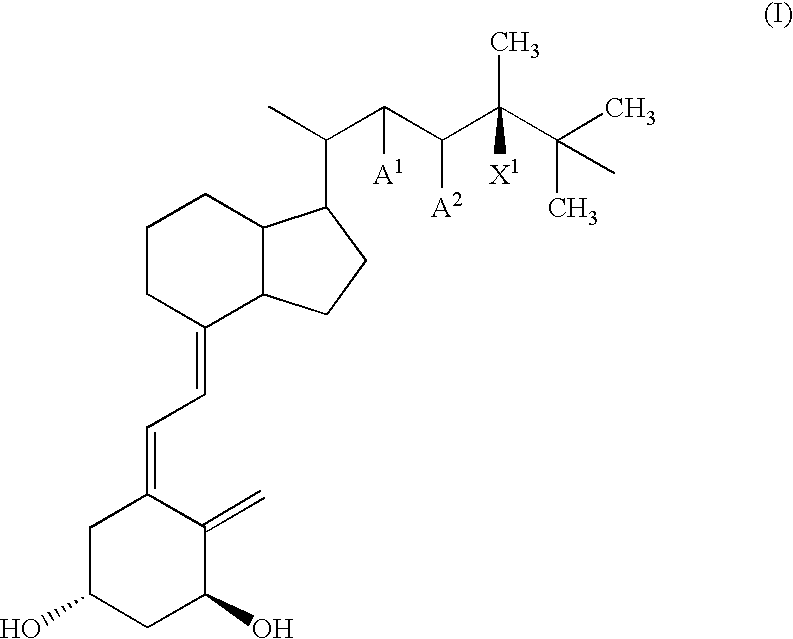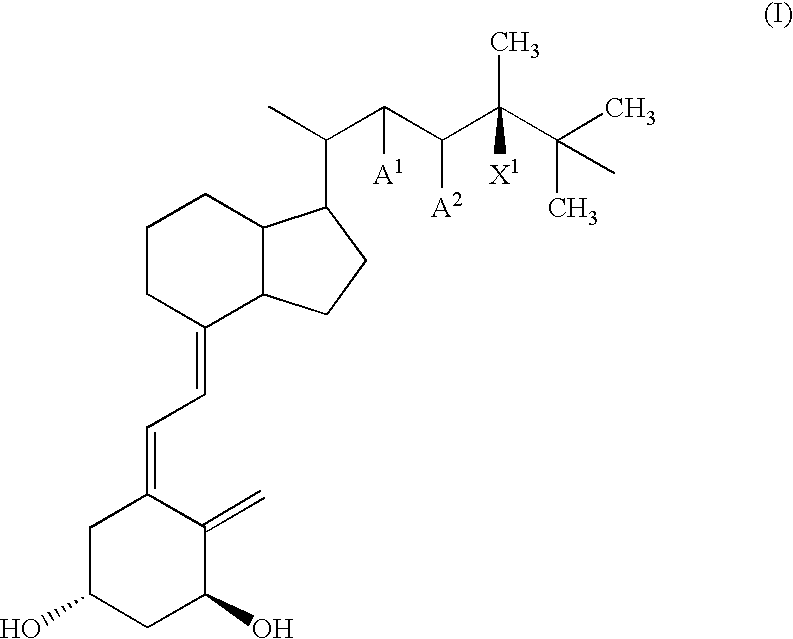Method of treating and preventing hyperparathyroidism with active vitamin d analogs
a technology of active vitamin d and hyperparathyroidism, which is applied in the direction of phosphorous compound active ingredients, drug compositions, peptide/protein ingredients, etc., can solve the problems of hypercalcemia and hypercalciuria, toxicity in the form of 1-hydroxylated vitamin d/sub>compounds can only be administered, and kidney damage is possible, so as to improve or prevent hyperparathyroidism, lowering or maintaining low blood parathyroid hormon
- Summary
- Abstract
- Description
- Claims
- Application Information
AI Technical Summary
Benefits of technology
Problems solved by technology
Method used
Image
Examples
example 1
Study Demonstrating Better Safety
[0055]The low toxicity of 1 α-(OH)D2 in human patients was demonstrated in a clinical study involving 15 postmenopausal osteoporotic women. [J. Bone Min. Res.; 9:607-614 (1994).]The selected patients were between 55 and 75 years of age, and exhibited L2-L3 vertebral bone mineral density (“BMD”) between 0.7 and 1.05 g / cm2, as determined by measurements with a LUNAR dual-photon absorptiometer. (The mean bone mineral density in women with osteoporosis is about 0.85±0.17 g / cm2, so that these limits correspond to about the 15th to 85th percentiles.)
[0056]On admission to the study, all patients received instruction on selecting a daily diet containing 400 to 600 mg of calcium. Compliance to this diet was verified at weekly intervals by 24-hour food records and by interviews with each patient.
[0057]All patients completed a one-week baseline period, a five- to seven-week treatment period, and a one-week post-treatment observation period. During the treatment...
example 2
Study Demonstrating Safety and Efficacy for Human Osteoporosis
[0061]The safety and efficacy of 1 α-(OH)D2 as an oral treatment for osteoporosis was confirmed in a study involving 60 postmenopausal osteoporotic outpatients. The selected subjects had ages between 60 and 70 years, and exhibited L2-L3 vertebral BMD between 0.7 and 1.05 g / cm2, as determined by dual-energy x-ray absorptiometry (DEXA). Exclusion criteria encompassed significant medical disorders and recent use of medications known to affect bone or calcium metabolism.
[0062]On admission to the study, each subject was assigned at random to one of two treatment groups; one group received up to a 104-week course of therapy with 1 α-(OH)D2; the other received only placebo therapy. All subjects received instruction on selecting a daily diet containing 700-900 mg of calcium and were advised to adhere to this diet over the course of the study. Compliance to the diet was verified at regular intervals by 24-hour food records and by ...
example 3
Open Label Study in End Stage Renal Disease Patients Exhibiting Secondary Hyperparathyroidism
[0092]Five end stage renal disease patients were enrolled in an open label study. The selected patients had ages between 36 and 72 years and had been on hemodialysis for at least 4 months prior to enrollment. The patients each had an average serum phosphorus in the range of 3.0 to less than or equal to 6.9 mg / dL during the two months prior to enrollment (often controlled by oral calcium as a phosphate binder e.g., calcium carbonate or calcium acetate), and had a history of elevated serum PTH values of greater than 400 pg / mL when not receiving 1 α,25-(OH)2D3 therapy.
[0093]Each patient had been receiving 1 α,25-(OH)2D3 prior to enrollment, and discontinued the 1 α,25-(OH)2D3 therapy for eight weeks prior to receiving 1 α-(OH)D2. After 8 weeks, the patients received treatment of 1 α-(OH)D2 at a dosage of 4 μg / day for 6 weeks. Throughout the eight-week washout period and the treatment period, pa...
PUM
| Property | Measurement | Unit |
|---|---|---|
| mass | aaaaa | aaaaa |
| bone mineral content | aaaaa | aaaaa |
| resistance | aaaaa | aaaaa |
Abstract
Description
Claims
Application Information
 Login to View More
Login to View More - R&D
- Intellectual Property
- Life Sciences
- Materials
- Tech Scout
- Unparalleled Data Quality
- Higher Quality Content
- 60% Fewer Hallucinations
Browse by: Latest US Patents, China's latest patents, Technical Efficacy Thesaurus, Application Domain, Technology Topic, Popular Technical Reports.
© 2025 PatSnap. All rights reserved.Legal|Privacy policy|Modern Slavery Act Transparency Statement|Sitemap|About US| Contact US: help@patsnap.com


